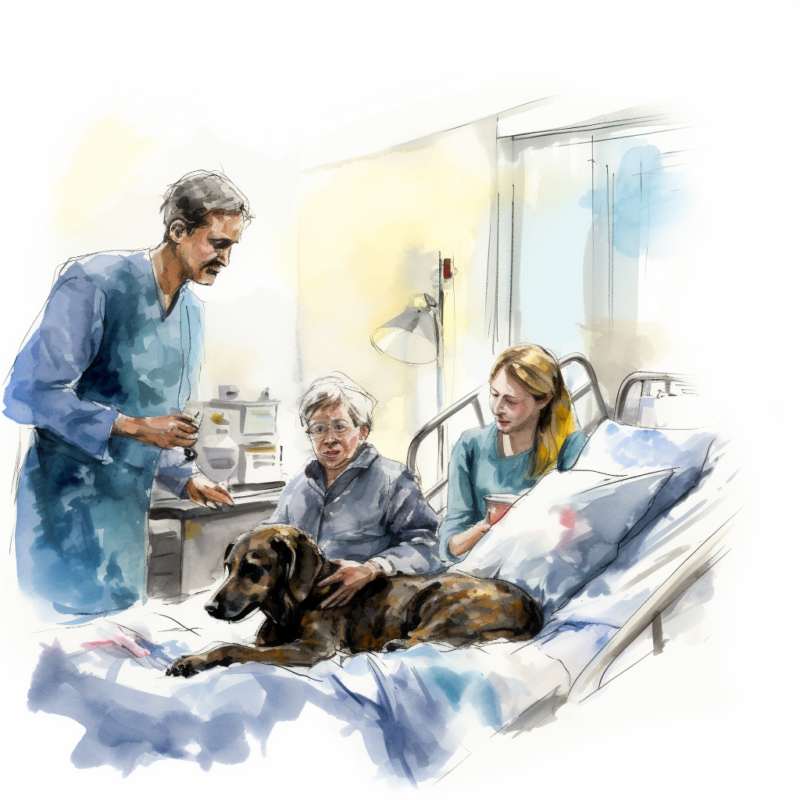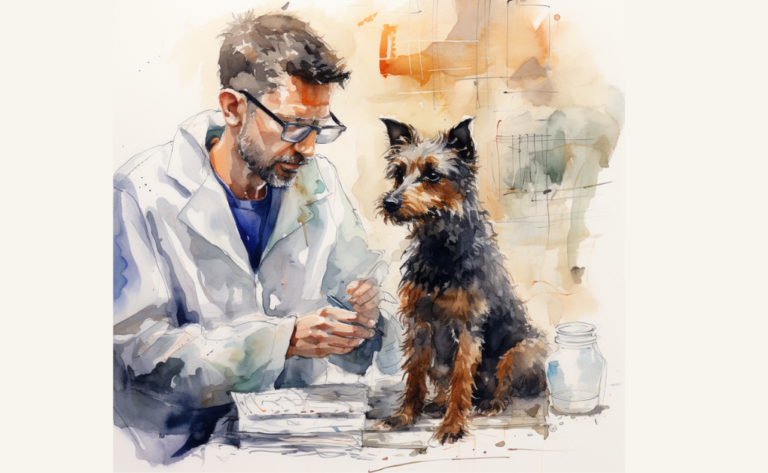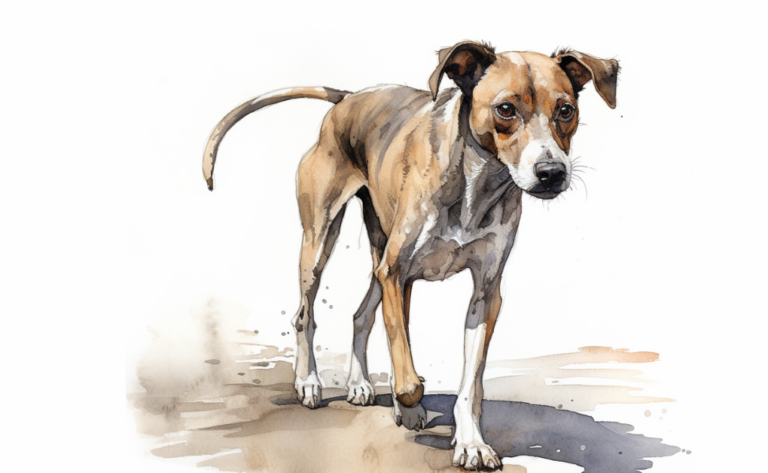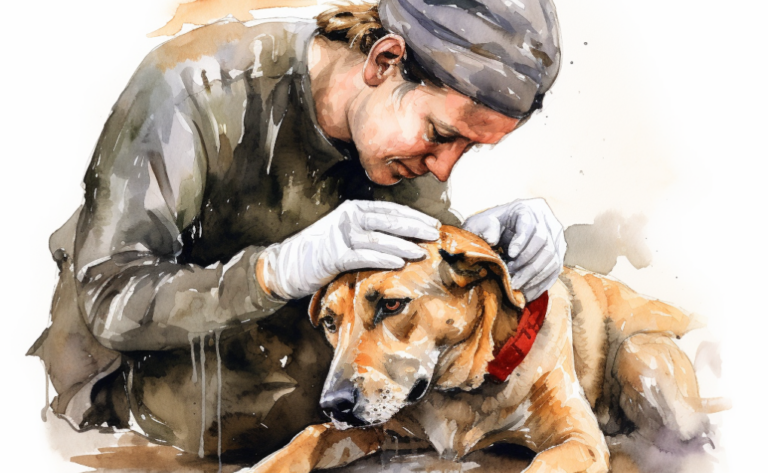What is Cancer in Dogs?
What is it?
How is it Treated?
Breed Predispositions
Golden Retriever Boxer Rottweiler Bernese Mountain Dog Great Dane Labrador Retriever Bulldog Beagle Bichon Frise Cocker Spaniel
Introduction
When Laura noticed a small lump on her cherished Golden Retriever, Charlie, she initially thought it was just a harmless bug bite or skin irritation. As weeks passed, however, the lump grew larger and more worrisome. Filled with concern, Laura took Charlie to the veterinarian for a thorough examination. She was devastated when the vet delivered the news that Charlie had cancer, a diagnosis she hadn’t expected.
Cancer in dogs, like humans, refers to the uncontrolled growth of cells that eventually forms tumors or spread throughout the body. Often extremely aggressive, these abnormal cells in a dog’s body don’t function like the dog’s normal cells. They can grow uncontrollably, invade surrounding tissues, and spread to other areas of the body, such as the lungs, causing damage to the dog’s health, hence posing a significant risk of cancer.
Cancer can affect virtually any part of the dog’s body, including the skin, leading to skin cancer. Different types of cancer, such as lung cancer, can behave very differently in a dog’s body. For instance, some grow slowly and may stay in one spot without spreading for years, while others grow rapidly and spread quickly to other organs.
Various types of cancer can develop in dogs, much like they can in humans. The most common types found in dogs include lymphoma, mast cell tumors, melanoma, and bone cancer. Each type of cancer affects the body differently, and the severity and prognosis can vary greatly depending on the type of cancer a dog has and the stage at which it is identified.
Cancer is a significant health problem, especially in certain breeds like the Irish Wolfhound. It is often the cause of death in older dogs, but it can occur in dogs of any age. However, many forms of cancer can be successfully treated or managed to provide the dog with a good quality of life. The specific outcome for a dog with cancer can depend on many factors, including the type and extent of the cancer and the treatment chosen.
Types Of Cancer In Dogs
Lymphoma
This type of cancer affects the lymph nodes and the immune system. It is a very common cancer in dogs and can be seen in any breed, though it is more prevalent in certain breeds. Lymphoma can manifest in various forms, and its effects on a dog can range from mild discomfort to severe illness. It accounts for approximately 25% of all canine cancer cases.
Hemangiosarcoma
Hemangiosarcoma is a cancer of the blood vessels. It often affects the heart or the spleen, leading to serious complications such as internal bleeding. This form of cancer is common in large-breed dogs and is typically aggressive with a poor prognosis.
Mast Cell Tumors
These are cancerous cells that can develop anywhere in the body but are most commonly found in the skin of about 20% of dogs. They can vary greatly in appearance, and their behavior can be unpredictable, with some growing slowly and others quickly. Mast cell tumors can cause discomfort, itchiness, and other skin-related issues.
Osteosarcoma
Osteosarcoma is a form of bone cancer often found in large and giant breed dogs. This aggressive cancer causes lameness and severe pain, and it can lead to fractures even from minor injuries due to the weakening of the bone structure.
Mammary Gland Tumors
These are common in unspayed female dogs. Just like human breast cancer, it can either be benign or malignant. Regular examinations of the mammary glands can help in early detection.
Melanoma
Melanomas in dogs are cancerous growths that typically arise from pigmented cells in the skin but can also occur in the mouth or toes. These tumors can be aggressive and metastasize to other areas of the body.
Each type of cancer can lead to various symptoms and health problems in dogs, affecting their quality of life and lifespan. In addition, treatment options and prognosis vary depending on the type stage of the cancer, as well as the overall health of the dog.
Causes of Cancer in Dogs
Just as it is with humans, the precise causes of cancer in dogs can be somewhat elusive, often involving a mix of genetic, environmental, and lifestyle elements. However, several key factors stand out:
- Genetic Factors – Certain breeds are more predisposed to specific cancer types, indicating genetic factors at play. For instance, Golden Retrievers are at an increased risk of developing lymphoma and hemangiosarcoma.
- Age – Cancer risk escalates as dog’s age. An older dog is more prone to cancer development than its younger counterparts.
- Environmental Influences – Contact with certain chemicals, toxins, or radiation can amplify the risk of developing dog cancer. A notable example is that exposure to second-hand smoke has been linked to lung and nasal tumors in dogs.
- Viral Impact – Certain viruses, like the canine papillomavirus, are connected with developing specific cancer types in dogs.
- Hormonal Influences – Females that haven’t been spayed are more susceptible to mammary gland tumors due to hormonal fluctuations related to heat cycles.
- Obesity and Diet – Mirroring the situation in humans, obesity and poor dietary habits can amplify the risk of developing specific cancers in dogs.
- Chronic Inflammation – Conditions characterized by long-term inflammation, such as chronic inflammatory bowel disease, can sometimes transition into cancer that develops in dogs, increasing the risk of gastrointestinal malignancies.
Grasping these risk factors can assist in early detection and potentially devising prevention strategies. In addition, regular veterinary check-ups and maintaining a healthy lifestyle are fundamental to ensuring a dog’s overall health, especially as the dog age and the risk of diseases, including cancer, increases.
Symptoms of Cancer in Canine
Certain types of cancer in pets can be straightforward to identify, while others can be considerably more elusive. As such, it’s crucial to promptly seek veterinary consultation if you observe any unusual changes in your pet’s health. Here are some clinical signs and warning signs of cancer in dogs that you should be vigilant about:

- Noticeable swellings or lumps that remain constant or exhibit progressive growth
- Sores that seem resistant to healing
- A decrease in body weight
- Reduced appetite
- Unexplained bleeding or discharge from any bodily opening
- A distinctly unpleasant odor
- Challenges when eating or swallowing
- Reluctance towards exercising or an apparent loss of stamina
- Persistent lameness or stiffness
- Difficulties when breathing, urinating, or defecating
However, remember that these clinical signs can also correspond to conditions other than cancer. Therefore, any sustained change in your dog’s health should trigger a visit to the vet for further examination. Vigilance and swift action can be crucial in detecting and treating cancer in pets early.
Diagnosis of Dog Cancer
Identifying cancer in dogs encompasses a multi-faceted approach, typically commencing with a meticulous physical examination and a thorough exploration of the pet’s health history. Here’s an overview of the standard procedures veterinary oncologists often follow to diagnose cancer –
- Physical Check-up – The process starts with a comprehensive physical examination. The vet checks for lumps, skin color alterations, or abnormal discharge – signs that may indicate the presence of a malignant tumor.
- Blood and Urine Analysis – Blood tests can spot systemic issues like changes in organ function, potentially indicative of cancer. Simultaneously, a urinalysis can highlight irregularities that might point toward certain types of cancer.
- Biopsy – When a suspicious lump is detected, a biopsy may be performed, involving the extraction of a small tissue sample for microscopic examination. This procedure often provides the most conclusive diagnosis of cancer.
- Imaging Techniques – Various imaging methods, such as X-rays, ultrasounds, CT scans, and MRIs, help detect tumors, ascertain their size and location, and check for metastasis (cancer’s spread to other body parts).
- Specialized Testing – Additional tests might be required depending on the type of suspected cancer. For example, bone marrow tests could be utilized for potential hematologic cancers, while endoscopy might be employed to inspect internal structures.
- Histopathology – If a tumor is surgically excised, it’s dispatched to a lab for histopathological examination. Here, a specialist scrutinizes the cells to validate the diagnosis and determine the grade and type of cancer.
Every diagnostic tool imparts valuable information to the veterinary oncologist. Occasionally, several tests may be necessary to diagnose accurately and stage cancer, which is pivotal in formulating the most effective treatment strategy.
In addition, advancements in cancer research, aided by organizations like the National Cancer Institute and the Veterinary Cancer Society, have paved the way for innovative diagnostic and therapeutic methods. Clinical trials, often involving specific dog breeds diagnosed with cancer, have become integral in developing promising new treatments.
Treatment for Dogs with Cancer
The treatment strategies for dogs diagnosed with cancer are multifaceted and largely hinge on the disease’s type and stage and the pet’s overall health. Here’s a summary of the prevalent methods employed in treating cancer in pets:
Surgery
One of the common forms of treatment for several types of canine cancer, surgery aids in the physical removal of tumors, thereby eradicating or reducing the presence of cancerous cells in the body. This procedure can significantly prolong the dog’s life and enhance its quality of life. If the cancer has not metastasized and is localized, surgery might even lead to a cure.
Surgery is often supplemented with other treatments like chemotherapy or radiation to optimize outcomes. Post-operative care, encompassing pain management, wound care, and vigilance for recurrence signs, is integral for recovery.

Chemotherapy
Chemotherapy entails the usage of drugs to eliminate cancer cells. It could be administered as a standalone treatment or in combination with other therapies. In addition, it might either be systemic (impacting the whole body) or localized, based on the cancer’s characteristics and extent.
Commonly used chemotherapy drugs and protocols in veterinary medicine include Cyclophosphamide, Doxorubicin (Adriamycin), Carboplatin and Cisplatin, Vinblastine and Vincristine, and Lomustine (CCNU). Each drug functions by causing DNA damage in cancer cells or inhibiting cell division or synthesis.
Radiation Therapy
As a focused treatment approach, radiation therapy employs high-energy radiation to damage the DNA of cancer cells, preventing them from multiplying and expanding. This therapy can be useful for treating localized tumors in dogs, either to reduce the tumor size or to slow its growth. However, as radiation concentrates on a specific region, side effects are often confined to the treated area and might include skin irritation or hair loss.
Immunotherapy
Immunotherapy, an innovative strategy in cancer treatment, harnesses the body’s immune system to combat cancer cells. It encompasses techniques such as vaccines, checkpoint inhibitors, and cell therapies. This approach can decelerate tumor growth, prevent cancer recurrence, and improve dogs’ overall quality of life.
Targeted Therapies
Targeted therapy is a specialized treatment that focuses on certain molecules or pathways involved in cancer growth and proliferation. Unlike traditional treatments, it aims to disrupt cancer cell function, inhibiting their proliferation and leading to their eventual demise.
Palliative Care
Palliative care is concentrated on managing the symptoms and side effects of the disease and its treatment, thus improving the quality of life for dogs with cancer. Palliative care can encompass medications to manage pain, dietary modifications to counter weight loss, and physical therapy to sustain mobility.
Clinical Trials
Clinical trials allow dogs to receive new and potentially more effective therapies before they are generally available. Participation can benefit the dog, especially when other treatments have failed or are not ideal, and contribute to a wider understanding of canine cancer.
The course of treatment will be tailored based on the type of cancer, its stage, the dog’s overall health, and its tolerance to treatment. Regular follow-ups will be necessary to monitor the dog’s response to treatment and adjust the plan. Treating cancer in pets often requires a multidisciplinary approach, including veterinary oncologists, surgeons, and radiologists, to ensure the best possible care.
Whether you’re a veterinary professional or a pet parent, the key is to be informed about the disease, the available treatment options, and how to provide the best care possible for a dog diagnosed with cancer. In emergencies, immediate care can make a significant difference. Similarly, staying abreast of the latest developments in comparative oncology can lead to breakthroughs in treatment options and improved outcomes.
Preventing Cancer in Dogs
While it’s impossible to prevent cancer completely, there are certain steps pet owners can take to minimize the risk:
- Regular Check-ups: Regular vet visits can help in the early detection and intervention of potential health issues, including cancer.
- Healthy Diet: A balanced, nutritious diet can strengthen a dog’s immune system and help prevent diseases. Some studies suggest that a diet rich in certain nutrients may have anti-cancer benefits.
- Maintaining a Healthy Weight: Obesity can increase the risk of certain cancers. However, regular exercise and portion control can keep your dog at a healthy weight.
- Limit Exposure to Carcinogens: Reduce exposure to known carcinogens like tobacco smoke, certain pesticides, and excessive sunlight.
- Regular Vaccinations: Vaccines protect against certain viral infections that can lead to cancer.
- Spaying/Neutering: Spaying or neutering your dog can lower the risk of certain types of cancer, such as breast or testicular cancer.
- Regular Dental Care: Regular dental cleanings can reduce the risk of oral cancers.
Remember, prevention is always better than cure. It’s about providing the best care and attention to your dog’s health and well-being.
Frequently Asked Questions
Disclaimer: The information provided on this veterinary website is intended for general educational purposes only and should not be considered as a substitute for professional veterinary advice, diagnosis, or treatment. Always consult a licensed veterinarian for any concerns or questions regarding the health and well-being of your pet. This website does not claim to cover every possible situation or provide exhaustive knowledge on the subjects presented. The owners and contributors of this website are not responsible for any harm or loss that may result from the use or misuse of the information provided herein.







